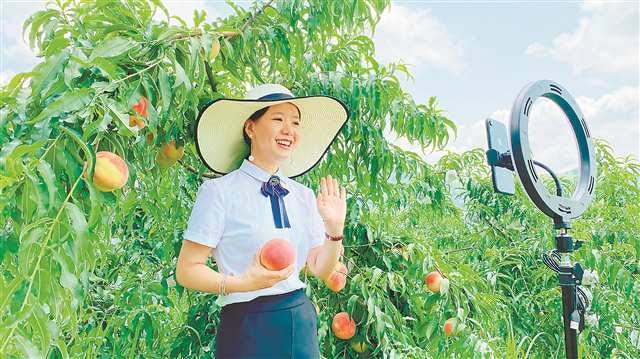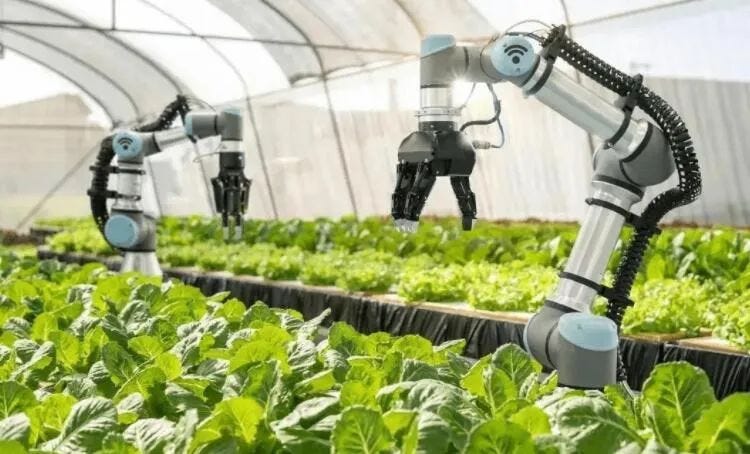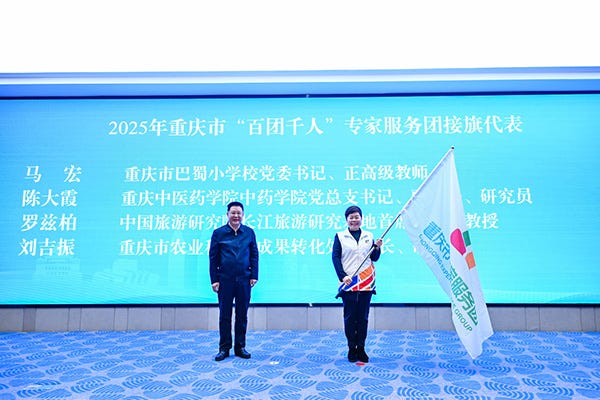The Harvest: This Week in Rural China – Dispatch No. 10 (21 February 2025)
Reality Check: Separating Hype from Hardship in Rural China

Welcome to this week’s edition of The Harvest.
In this dispatch:
The Rise of “Celebrity Net Farmers” – Livestreaming farmers are being hailed as the future of rural e-commerce, but is this a real solution or just a temporary fix?
Fact-Checking China’s Agricultural Technology Claims – Beijing claims global leadership in agri-tech—how much is real progress, and how much is propaganda?
Chongqing’s Rural Workforce Plan—This new initiative aims to revitalise the countryside by attracting skilled talent and keeping young workers local.
China’s Record Grain Harvest – Officials project an all-time high yield, but does higher yield signify progress or overproduction?
Hunan’s Housing Reforms for Farmers – Streamlining rural housing approvals to boost development—practical policy or bureaucratic reshuffle?
This has been a week of bold claims from the Chinese government and state media regarding rural China—grand narratives about agricultural innovation, workforce revitalisation, and record-breaking harvests. But how much of it holds up under scrutiny? This edition of The Harvest pushes back, breaking down the reality behind these official statements.
I am always eager to hear your opinions—your feedback shapes the direction for every edition. Please share your thoughts in the comments below or email me at nathan@thisweekinruralchina.com.
As a reminder, The Harvest will always remain free for all. But if you’ve found value in our work and want to support the continued growth of this project, consider becoming a paid subscriber. Your support helps us improve and fuels the commitment to publish twice a week, every week:
As always, I’m grateful for your continued readership. Now, let’s dive into this week’s dispatch.
China’s ‘Celebrity Net Farmers’ Boom: Reality or Mirage?
This week, Xinhua News Agency has been busy promoting a familiar success story: rural revitalisation through e-commerce. In the hills of Gansu’s Loess Plateau, where farming was once backbreaking and isolated, villagers now live-stream their produce to a nationwide audience. According to Xinhua, these so-called “网红农业” or “Celebrity Net Farmers” are reviving local traditions, selling hand-crafted goods, and lifting themselves out of poverty—all thanks to digital platforms like Douyin and Kuaishou.
It’s a compelling narrative but one that warrants closer scrutiny. While Xinhua frames this as an organic, farmer-led transformation, it is, in reality, a state-engineered push. The Chinese government has spent years funnelling resources into rural e-commerce, positioning it as a pillar of its broader rural revitalisation strategy. The Ministry of Agriculture reports that digital sales from rural areas reached 2.17 trillion yuan in 2023, with livestreaming hailed as a key driver. The implication? Rural China doesn’t need land reform, higher wages, or major policy shifts—just a good internet connection and a smartphone.
But this narrative glosses over deeper issues. The idea that struggling farmers can simply “直播致富” —“stream their way to prosperity”—ignores the harsh realities of China’s rural economy. Yes, some individuals have found success marketing their homemade snacks. However, many remain dependent on platform algorithms and government support. The boom in rural e-commerce is often less about agriculture and more about performance—where selling produce takes a back seat to curating an aesthetic of rustic authenticity for urban consumers nostalgic for a countryside they’ve never lived in.
China’s countryside is changing, but not necessarily in the way Xinhua suggests. Net farming might offer a lifeline for some, but it’s no substitute for deeper structural reforms. Instead, it raises a bigger question: if rural China’s future depends on livestreaming and online sales, what does that say about the real state of farming today?
Fact-Checking China’s Agricultural Technology Claims
China’s Ministry of Agriculture and Rural Affairs (MARA) has once again asserted that the country is leading the world in agricultural technology. This week, reports from the 2024 China Agricultural Science and Technology Development Forum (2024中国农业科技发展论坛) have resurfaced, reinforcing a narrative of global dominance in agri-tech. However, closer scrutiny reveals a more nuanced reality.
Assessing the Evidence
A Global Leader in Agricultural Science? MARA claims that China leads in agricultural science papers and patents. While China Agricultural University (CAU) ranks ninth globally for Agriculture and Forestry (topuniversities.com), definitive data supporting claims of outright global preeminence remains elusive. There are far more top-ranking universities in the United States and Europe which offer agricultural programmes. The volume of research output by Chinese institutions is significant, but its impact—measured by citation and practical application—is harder to quantify.
Surpassing the U.S. in Innovation? The claim that China has overtaken the United States in agricultural research output and quality over the past six years is ambitious. Although investment in agri-tech has increased substantially, the U.S. remains dominant in key fields such as precision agriculture and biotechnology. While China is rapidly expanding its capabilities, a comprehensive overtaking of the U.S. is yet to be substantiated by independent, global assessments.
The Patent Leadership Debate: MARA suggests China now leads in agricultural patent competitiveness, filing over half of the world’s agricultural invention patents. However, verifying this claim is challenging, as no clear international dataset corroborates the assertion. Moreover, the number of patents does not necessarily equate to technological superiority or widespread adoption.
Dominance in Agricultural Research Hotspots? China is reportedly a key player in six out of nine global agricultural disciplines, outpacing traditional leaders such as the U.S., Germany, and the UK. While China’s influence in agricultural research is undoubtedly expanding, it remains unclear whether this equates to tangible advances in practical farming efficiency or yield improvements at scale.
Although the 2024 China Agricultural Science and Technology Development Forum took place in October 2024, these claims are re-emerging in the news cycle due to a concerted public relations effort. As China prioritises food security and extends its agricultural partnerships—particularly in Africa—the government is keen to project an image of technological leadership. This renewed push aligns with broader strategic objectives, including reducing reliance on foreign agricultural imports and positioning China as a global agronomic innovator.
China’s advancements in agricultural technology are real and significant, but claims of outright global leadership require a more cautious assessment. While research output and patents are growing, the practical impact and innovation quality remain open to scrutiny. As always, separating genuine progress from strategic messaging is essential. Expect more of these claims as Beijing seeks to position itself as a global agronomic powerhouse.
Chongqing’s Rural Talent Revitalisation Plan: Grand Ambitions, Hard Realities
In a bid to reshape its rural workforce, Chongqing has launched the Rural Talent Revitalisation Action Plan (乡村人才振兴行动计划), unveiled at a key conference on 18 February 2025. Running from 2025 to 2030, the plan aims to attract skilled professionals to China’s countryside, tackling the entrenched challenges of rural depopulation and economic stagnation.
The plan outlines efforts to strengthen rural industries, ecological conservation, cultural heritage, tourism, public services, and expert-led development. Among its 20 initiatives, the most eye-catching is the creation of industry service teams (产业服务团)—100 teams per year, composed of specialists tasked with revitalising local economies. These teams will support rural businesses, from traditional agriculture to emerging sectors like eco-tourism and green energy.
A special focus is placed on preserving traditional crafts through the development of artisan talent (守艺人人才), an initiative designed to sustain ethnic handicraft skills. This aligns with Beijing’s broader strategy of leveraging rural heritage as a soft power asset.
Beyond industry, the plan also seeks to bolster public services, with 4,000 new township employees set to be recruited this year alone. Additionally, a talent development chain (人才发展链) aims to establish a long-term pipeline for rural professionals, with a target of training and retaining 200,000 individuals by 2030.
Chongqing’s Rural Talent Revitalisation Action Plan is an assertive step toward narrowing China’s rural-urban divide. The structural issues it seeks to address are real. However, its success hinges on execution, talent retention, and whether rural industries can truly offer competitive opportunities. The real test will be the gap between policy ambition and on-the-ground realities.
China Projects Record Harvest: A Step Toward Food Security
China is set to achieve a historic milestone, with grain output projected to surpass 1.4 trillion jin (700 million tonnes) for the first time this year. If realised, this would mark nine consecutive years of stable growth, reinforcing the country’s push for agricultural self-sufficiency.
Corn is expected to drive this year’s gains, with expanded acreage contributing significantly to overall yield. Summer crops, including early rice, are on track to remain strong at over 563.5 billion jin. At the same time, soybean and rapeseed production are also forecast to hold steady. Despite concerns over adverse weather, authorities believe crop damage will remain below average thanks to government-backed resilience measures.
To secure this success, China’s Ministry of Agriculture and Rural Affairs this week launched an ambitious 120-day campaign (奋战120天抓春管提单产夺夏收粮油丰收行动) to maximise spring planting and safeguard the upcoming harvest. Running from the spring until midsummer, the initiative focuses on boosting crop yields, strengthening disaster resilience, and supporting farmers with targeted training and pest control measures, including the “One Spray, Three Defenses” (一喷三防) strategy for wheat. State media increasingly portrays spraying as being done by drones, as shown in the picture above, but in reality, much of it is still carried out by hand or tractor.
Despite its strengths, China’s food security strategy faces structural vulnerabilities. The country is largely self-sufficient in staples like rice, wheat, and corn yet remains heavily reliant on soybean imports. Increasing harvest yields of the staple crops does little to combat this. Initiatives like the Soybean Action Plan (“大豆和油料产能提升工程”) aim to bridge this gap, but progress is slow. Meanwhile, the government is tightening farmland protections to maintain its crucial 1.8-billion-acre “red line” amid growing urban expansion.
These efforts are set against a worsening global food crisis. The World Food Programme reports that 7 million more people worldwide face hunger than last year despite rising grain production. While China’s agricultural sector remains resilient, securing long-term food stability will require sustained policy intervention, land preservation, and reduced import dependency—issues that are rarely addressed in recent press releases on the record harvest.
For now, the country is on track for a record harvest, but the real question is whether higher yields will translate into genuine food security and a diverse, sustainable supply—or merely result in the overproduction of staple crops.
Hunan Pioneers Streamlined Rural Housing Approval
Hunan Province is cutting through China’s notorious rural red tape with a sweeping reform that promises to transform how farmers build their homes. A new digital system will allow rural residents to apply for housing approvals online, slashing waiting times and bureaucratic obstacles that have long frustrated the countryside.
Until now, securing permission to build in rural China meant navigating a maze of government offices, submitting piles of paperwork, and enduring months of delays. However, in a trial launched in Yiyang City, Hunan has taken a bold step to change that. Through the province’s “One Network for All Services” (一网通办) platform, farmers can now submit applications via mobile or desktop in minutes—bypassing the need for in-person visits and endless form-filling. The system integrates local land, housing, and agricultural authorities, ensuring faster approvals and fewer administrative snags.
The province aims to cut approval times to just 16 working days by mid-2025, halving the costs of paperwork and travel. Officials say the move will not only ease the burden on farmers but also improve efficiency for local governments, allowing them to process applications through a single, unified system.
Hunan’s push for reform has drawn national attention, with policymakers hailing it as a model for wider adoption. For a province with deep rural roots, this experiment signals a broader shift. As China modernises its countryside, a more streamlined, farmer-friendly approach to governance may well be the way forward.
If you missed it, have a read of our feature story on rural housing from earlier this week: When Walls Crumble: The Transformation of Rural Chinese Architecture.
Between Mountains and Waters - Photo of the Week for 21 February 2025
An aerial view captures farmers operating agricultural machines at a sugarcane base in Laibin City, Guangxi Zhuang Autonomous Region, on 19 February 2025. As early spring unfolds, farming activities across China intensify, blending tradition with modern efficiency. (Xinhua/Zhou Hua)









This is excellent reporting, thank you! It always amazes me how close so-called 'capitalism' and 'communism' are to each other when centralised control whether through the party or government and business regulation remain stubbornly at the helm.
Also, I realise reading your analysis how marketing (including propaganda) has become the centrepiece of both economic systems in their most representative territories (US & China).
All the way, and as you well point out, the plight of the farmer, the rural family, remains the same or perhaps worse (with notable exceptions), not only do they remain totally dependent on the weather (for the most part unavoidable), but now depend equally and fatefully on government. Are 2 dependencies better than one?
“Rural China doesn’t need land reform, higher wages, or major policy shifts—just a good internet connection and a smartphone.”
Why, why, WHY is the solution always to further centralize services onto these devices? I was just complaining the other day that having one’s entire life tied up into a phone strips life of a bit of color. Convenience is the name of the game, more so in China than anywhere else, but is it even all that good? It’s taking over as the only viable means of living. Of course, it does come with its benefits, like the 一网通办 you brought up. But it means you NEED a phone, and thus extend the surveillance state, increasing likelihood of douyin addiction and scams.
If China really can up their farming game, the world would be better off, but only if there are good channels for trade. Otherwise, most of it is blowing smoke.